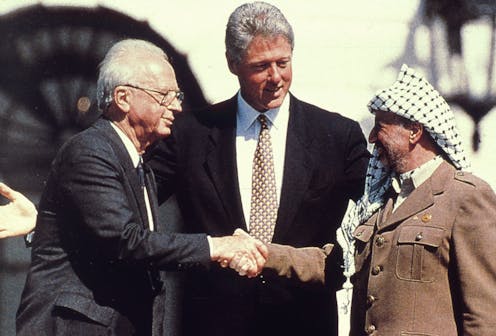30 years after Arafat-Rabin handshake, clear flaws in Oslo Accords doomed peace talks to failure
- Written by Maha Nassar, Associate Professor in the School of Middle Eastern and North African Studies, University of Arizona

On Sept. 13, 1993, the world watched as Israeli Prime Minister Yitzhak Rabin and Palestine Liberation Organization Chairman Yasser Arafat shook hands on the White House lawn[1]. It was a stunning moment. The famous handshake between adversaries marked the beginning of what became known as the Oslo Accords[2], a framework for talks between Israeli and Palestinian representatives, mediated by U.S. diplomats.
The idea was that through open-ended negotiations and confidence-building measures, Palestinians would eventually take control over their own affairs in the West Bank, Gaza Strip and East Jerusalem – territories that Israel[3] had illegally occupied following the 1967 Six-Day War[4].
After an interim period of five years[5], the thinking went, a Palestinian state would exist side by side with Israel. And through such a two-state solution, peace between Israel and the Palestinians could be achieved.
Thirty years later, it is clear the Oslo Accords have achieved neither peace nor a two-state solution. So far in 2023 alone, over 200 Palestinians and nearly 30 Israelis have been killed[6]. Israel has the most right-wing, nationalist government[7] in its history, and the Palestinian leadership is weak and divided[8]. There is little prospect for a return to negotiations anytime soon.
How did this grim reality emerge from such high hopes in 1993? Many analysts point to violations of the terms of the accords[9] committed by both sides. Others blame a lack of accountability[10], which allowed those violations to go unchecked.
Certainly, there is plenty of blame to go around. But as a scholar of Palestinian history[11], it is clear to me that the Oslo peace process failed because the framework itself was deeply flawed in three key ways.
First, it ignored the power imbalance between the two sides. Second, it focused on ending violence by Palestinian militant groups while overlooking acts of violence committed by the Israeli state[12]. And third, it sought peace as the end goal, rather than justice.
Let’s break each one of these down.
Ignoring the power imbalance
The Palestinian Liberation Organization, or PLO, had implicitly recognized Israel[13] in 1988. But a more formal statement was needed[14] for Israel to agree to talks. In an exchange of letters on Sept. 9, 1993, Arafat wrote to Rabin[15], “The PLO recognizes the right of the State of Israel to exist in peace and security.”
In formally recognizing Israel’s right to exist, the PLO essentially gave up sole sovereign claims to 78% of the Palestinians’ historic homeland[16] that was now claimed by Israel.
In response, Rabin wrote to Arafat[17] that Israel would “recognize the PLO as the representative of the Palestinian people.” He did not recognize the Palestinians’ right to form their own state.
In a “Declaration of Principles[18],” signed by Arafat and Rabin at the White House on Sept. 13, it was stated that the aim of the talks was “the implementation of Security Council resolutions 242 (from 1967) and 338 (from 1973).” Those U.N. resolutions call on Israel to withdraw from territories it occupied in 1967. But they do not explicitly call for the establishment of a Palestinian state.
Since then, Israel has expropriated nearly half[19] of the West Bank for the exclusive use of Jewish settlers, in violation of international law[20]. It also routinely siphons off[21] water from Palestinian underground aquifers for the use of the settlers, while depriving[22] Palestinians access to their own water.
As a result of these and other measures[23], life for Palestinians became worse[24] during the post-Oslo years, not better. As Palestinians lost further control over their lands, homes and resources, their ability to establish a state grew more distant.
Yet, by insisting that bilateral negotiations take place between a powerful state and a stateless people – rather than under the auspices of the United Nations or other international body – the Oslo framework ignored the power imbalance between Israel and the Palestinians. U.S. mediators would insist that both sides[25] needed to compromise. But Israel held far more military, economic and diplomatic power than the Palestinians.
By ignoring this power imbalance, the Oslo Accords effectively allowed Israel to continue to confiscate land and resources with no consequences. With 60% of the West Bank under Israeli control[26], the prospects for a viable, independent Palestinian state were undermined.
No end to state violence
A 1994 follow-up agreement stated[27], “Both sides shall take all measures necessary in order to prevent acts of terrorism, crime and hostilities directed against each other.” It added that “the Palestinian side shall take all measures necessary to prevent such hostile acts directed against the Settlements, the infrastructure serving them and the Military Installation Area.”
Successive Israeli governments have interpreted “hostile acts” broadly. As a result, even Palestinians who have defended their lands through nonviolent means have been arrested[28], imprisoned[29] and shot at[30] by Israeli soldiers.
The agreement also stated[31] that “the Israeli side shall take all measures necessary to prevent such hostile acts emanating from the Settlements and directed against Palestinians.” But it does not mention Israeli military violence against Palestinian civilians.
To enforce this agreement, the Palestinian Authority – an autonomous body that rules over Palestinians in the West Bank – agreed to coordinate[32] with the Israeli military over security matters. It would either arrest Palestinians whom Israel suspects of carrying out hostilities or allow Israel to enter Palestinian areas and arrest suspects themselves.
This coordination protects Israelis from Palestinian violence, but it does not protect Palestinians from violence by the Israeli military. Since fall 2000, the Israel military has killed eight times[33] as many Palestinians as compared with Israelis killed by Palestinians. Half of those Palestinian victims were not involved in hostilities[34] when they were killed, according to analysis from the Israeli human rights group B'Tselem.
Palestinians are also subjected to other kinds of human rights abuses from the Israeli state. These include home demolitions[35], imprisonment without charge or trial[36] and abuse[37] at checkpoints[38]. Most soldiers accused of harming Palestinians do not face consequences[39] for their actions, according to Yesh Din, an Israeli human rights organization.
Peace over justice
This kind of structural violence and abuse – perpetrated by the state against marginalized groups – rarely makes headlines in Western media. Such a lack of awareness reinforces Israel’s ability to control Palestinians’ lives and further undermines the prospects for peace.
Yet this exclusive focus on achieving peace has, I believe, also been part of the problem. American and Israeli diplomats narrowly defined peace[40] as the absence of armed violence and set that as the overarching goal. They believed that if Palestinians refrained from committing acts of violence, then peace through a two-state solution could be achieved. Coverage that mirrored this perspective in the mainstream U.S. media further entrenched[41] this view.
But this understanding of peace has ignored the Palestinians’ need for justice. At a minimum, justice to many Palestinians would have meant an end to security cooperation[43] between the Palestinian Authority and Israel and the establishment of an independent, democratic Palestinian state on the remaining 22% of their homeland[44].
But with the power imbalances enshrined in the Oslo framework, and with U.S. mediators focusing more on peace – measured by incidents of Palestinian violence over those perpetrated by the Israeli state – this was not to be.
Oslo as ‘surrender’
One month after the famous handshake, the Palestinian scholar Edward Said described[45] the Oslo Accords as “an instrument of Palestinian surrender.” Recently, a group of leading political scientists called on U.S. policymakers to abandon[46] the Oslo framework and the two-state solution altogether. They call on the U.S. to “advocate for equality, citizenship, and human rights for all Jews and Palestinians living within the single state dominated by Israel.”
It is, I believe, an urgent call. Life for Palestinians is getting worse, not better. A growing number of international human rights organizations[47] and public figures[48] describe the current reality on the ground in Israel-Palestine as a form of apartheid[49].
Thirty years after their famous handshake, Arafat and Rabin have long since passed. It’s time to admit that the process they kick-started is also now confined to history.
References
- ^ shook hands on the White House lawn (www.npr.org)
- ^ Oslo Accords (peacemaker.un.org)
- ^ territories that Israel (www.un.org)
- ^ illegally occupied following the 1967 Six-Day War (www.globalr2p.org)
- ^ interim period of five years (2001-2009.state.gov)
- ^ have been killed (www.aljazeera.com)
- ^ the most right-wing, nationalist government (www.pbs.org)
- ^ Palestinian leadership is weak and divided (www.haaretz.com)
- ^ violations of the terms of the accords (www.youtube.com)
- ^ lack of accountability (carnegieendowment.org)
- ^ scholar of Palestinian history (menas.arizona.edu)
- ^ acts of violence committed by the Israeli state (www.aljazeera.com)
- ^ implicitly recognized Israel (www.nytimes.com)
- ^ was needed (mesg.wordpress.hull.ac.uk)
- ^ Arafat wrote to Rabin (www.un.org)
- ^ 78% of the Palestinians’ historic homeland (imeu.org)
- ^ Rabin wrote to Arafat (www.un.org)
- ^ Declaration of Principles (www.un.org)
- ^ expropriated nearly half (www.haaretz.com)
- ^ in violation of international law (press.un.org)
- ^ siphons off (apnews.com)
- ^ depriving (reliefweb.int)
- ^ and other measures (www.unrwa.org)
- ^ became worse (www.btselem.org)
- ^ both sides (www.nytimes.com)
- ^ under Israeli control (unctad.org)
- ^ follow-up agreement stated (peacemaker.un.org)
- ^ have been arrested (www.npr.org)
- ^ imprisoned (www.amnesty.org)
- ^ shot at (www.opendemocracy.net)
- ^ agreement also stated (peacemaker.un.org)
- ^ agreed to coordinate (www.peaceagreements.org)
- ^ eight times (statistics.btselem.org)
- ^ not involved in hostilities (statistics.btselem.org)
- ^ home demolitions (www.pbs.org)
- ^ imprisonment without charge or trial (apnews.com)
- ^ abuse (www.haaretz.com)
- ^ at checkpoints (www.unocha.org)
- ^ do not face consequences (s3.eu-west-1.amazonaws.com)
- ^ narrowly defined peace (www.c-span.org)
- ^ further entrenched (www.972mag.com)
- ^ Said Khatib/AFP via Getty Images (www.gettyimages.com)
- ^ an end to security cooperation (al-shabaka.org)
- ^ remaining 22% of their homeland (www.reuters.com)
- ^ Palestinian scholar Edward Said described (www.lrb.co.uk)
- ^ called on U.S. policymakers to abandon (www.foreignaffairs.com)
- ^ international human rights organizations (www.hrw.org)
- ^ public figures (sites.google.com)
- ^ Israel-Palestine as a form of apartheid (www.amnesty.org)
Authors: Maha Nassar, Associate Professor in the School of Middle Eastern and North African Studies, University of Arizona



